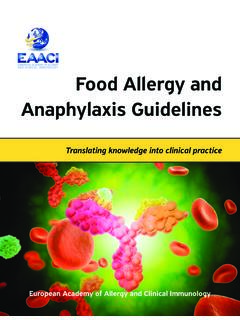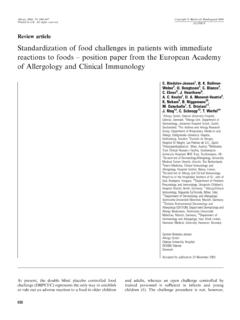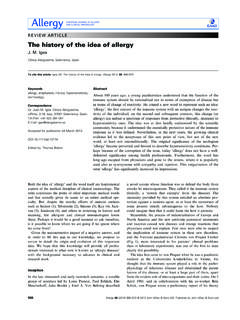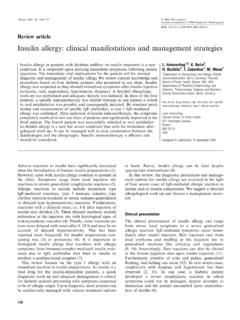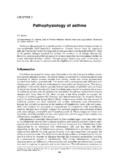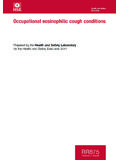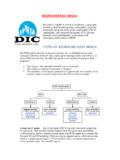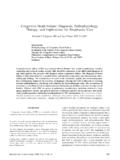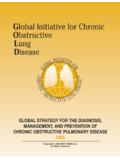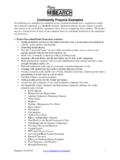Transcription of Diagnosis and treatment of asthma in childhood: a …
1 Review articleDiagnosis and treatment of asthma in childhood : a PRACTALL consensus reportAsthma is the leading chronic disease among children in most industrializedcountries. However, the evidence base on specific aspects of pediatric asthma ,including therapeutic strategies, is limited and no recent international guidelineshave focused exclusively on pediatric asthma . As a result, the European Acad-emy of Allergy and Clinical Immunology and the American Academy of Allergy, asthma and Immunology nominated expert teams to find a consensus to serve asa guideline for clinical practice in Europe as well as in North America.
2 Thisconsensus report recommends strategies that include pharmacological treatment ,allergen and trigger avoidance and asthma education. The report is part of thePRACTALL initiative**, which is endorsed by both B. Bacharier1, A. Boner2, Carlsen3, P. A. Eigenmann4,T. Frischer5, M. G tz6, P. J. Helms7,J. Hunt8, A. Liu9, N. Papadopoulos10,T. Platts-Mills11, P. Pohunek12,F. E. R. Simons13, E. Valovirta14,U. Wahn15, J. Wildhaber16, TheEuropean Pediatric asthma Group*1 Department of Pediatrics, Washington University,St Louis, MO, USA;2 Department of Pediatrics,University of Verona, Verona, Italy;3 Department ofPediatrics, University of Oslo, Oslo, Norway;4 PediatricAllergy, University Children s Hospital of Geneva,Geneva, Switzerland;5 University Children s HospitalVienna, Vienna, Austria;6 Department of Paediatrics &Adolescent Medicine, Medical University of Vienna,Vienna, Austria.
3 7 Department of Child Health, Universityof Aberdeen, Aberdeen, Scotland;8 Department ofPediatrics, University of Virginia, Charlottesville, VA,USA;9 Department of Pediatrics, National JewishMedical and Research Center, University of ColoradoSchool of Medicine, Denver, CO, USA;10 Allergy ResearchCenter, Allergy Research Center, Goudi, Greece;11 Allergyand Clinical Immunology, University of Virginia,Charlottesville, Virginia, USA;12 Department ofPediatrics, University Hospital Motol, Charles University,Prague, Czech Republic;13 Department of Pediatrics andChild Health, University of Manitoba, Winnipeg,Manitoba, Canada;14 Turku Allergy Center, Turku,Finland;15 Department of Medicine, The Charit University of Berlin, Berlin, Germany;16 Department ofRespiratory Medicine, University Children s Hospital,Zurich, SwitzerlandKey words: Diagnosis ; education; guidelines; monitoring;pediatric asthma .
4 WahnCharit Universit tsmedizin BerlinAugustenburger Platz 1D-13353 BerlinGermany*The European Pediatric asthma Group: Eugenio Baraldi,Dietrich Berdel, Eddy Bodart, Attilo Boner, Liberio JoseDuarte Bonifacio Ribiero, Anna Breborowicz, Karin drup Carlsen, Kai-H kon Carlsen, Fernando Maria deBenedictis, Jacques de Blic, Kristine Desager, Philippe , Basil Elnazir, Alessandro Fiocchi, ThomasFrischer, Peter Gerrits, Jorrit Gerrritsen, Manfred Gotz,Peter Greally, Peter J. Helms, Merja Kajosaari, OmerKalayci, Ryszard Kurzard, Jose Manuel Lopes dos Santos,Kristiina Malmstrom, Santiago Nevot, Antonio NietoGarcia, Nikos Papadopoulos, Anna Pelkonen, PetrPohunek, Frank Riedel, Jose Eduardo Rosado Pinto,Juergen Seidenberg, Erkka Valovirta, Wim MC vanAalderen, David Vaughan, Ulrich Wahn, JohannesWildhaber, Ole D.
5 Wolthers.**The PRACTALL program is supported by anunrestricted educational grant from Merck Co. Inc. underthe auspices of Charit University of for publication 11 October 2007 Abbreviations:ACT, asthma Control Test; DPI, dry powder inhaler; eNO, exhaled nitricoxide; FEF, forced expiratory flow; FEV1,forced expiratory volume; FVC, forced vitalcapacity; GP, general practitioners; HPA, hypothalamic pituitary adrenal; ICS, inhaledcorticosteroids; IgE, immunoglobulin E; IL, interleukin; LABA, long-actingb2 receptoragonist; LTRA, leukotriene receptor antagonist; MDI, metered dose inhaler; nNO, nasalnitric oxide.
6 PEF, peak expiratory flow; SLIT, sublingual 2008: 63: 5 34 2008 The AuthorsJournal compilation 2008 Blackwell MunksgaardDOI: is the most common chronic childhood disease innearly all industrialized countries. It is more prevalent inchildren with a family history of atopy, and symptomsand exacerbations are frequently provoked by a widerange of triggers including viral infections, indoor andoutdoor allergens, exercise, tobacco smoke and poor airquality. Many infants and preschool children experiencerecurrent episodes of bronchial symptoms, especiallywheezing and cough, beginning at a few months of age,mainly during a lower respiratory tract infection, andsince a clinical Diagnosis of asthma usually can be madewith certainty by age 5, the early Diagnosis , monitoringand treatment of respiratory symptoms are the time of this report, there are few national (1 4)and no up-to-date international guidelines (5)
7 That focusexclusively on pediatric asthma , even though childrenhave a higher overall prevalence of asthma compared toadults. Pharmacotherapy for childhood asthma has beendescribed in general asthma guidelines, including therecently updated Global Initiative for asthma (GINA)guidelines (6) and in some national guidelines. However,the information available on specific aspects of pediatricasthma, in particular in children under 5 years of age, islimited and does not include the opinion and contribu-tions of the pediatric allergy and respiratory community(1, 7, 8).
8 In contrast to adults, the evidence base forpharmacotherapy in children under 5 years of age is verysparse. The current British Thoracic Society Guideline (9)has been the most accessible source of information fortreatment of pediatric asthma , with recommendationsbased on the available literature and where evidence islacking on expert view of the limited data from randomized controlledtrials in children and the difficulties in applying systematicreview criteria to Diagnosis , prognosis and nonpharma-cological management, this report employed a consensusapproach based on available published literature (untilJune 2007)
9 And on best current clinical practice. Thereport reviews the natural history and pathophysiology ofpediatric asthma and provides recommendations fordiagnosis, practical management and monitoring. Therecommendations are aimed at both pediatricians andgeneral practitioners (GPs) working in hospitals, office orprimary care historyAsthma in children can be described as repeated attacksof airway obstruction and intermittent symptoms ofincreased airway responsiveness to triggering factors, suchas exercise, allergen exposure and viral infections (10).
10 However, the definition becomes more difficult to applyconfidently in infants and preschool age children whopresent with recurrent episodes of coughing and/orwheezing. Although these symptoms are common in thepreschool years, they are frequently transient, and 60% ofchildren with infantile wheeze will be healthy at school age(11). Physicians should manage and exclude diagnosesother than asthma , and be aware of the variable naturalhistory patterns of recurrent wheezing in early different patterns of recurrent wheeze in pediat-ric patients have been proposed (12), and a fourth wasrecently described (13).
